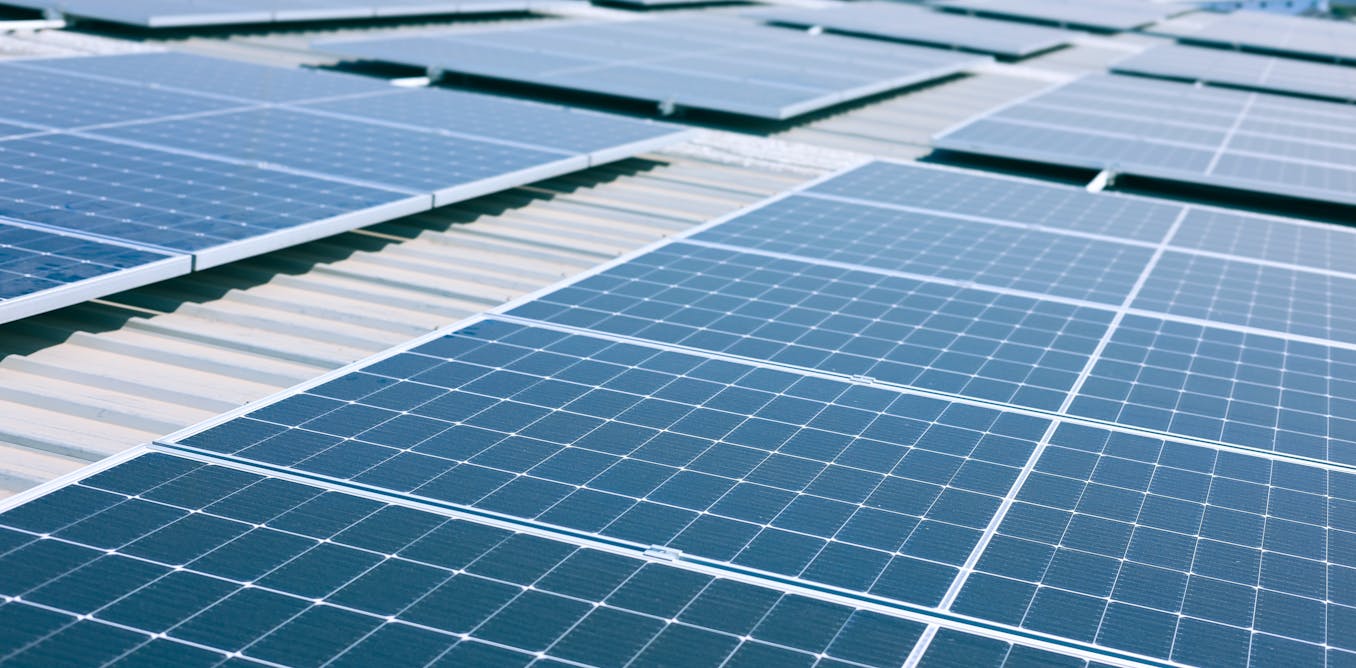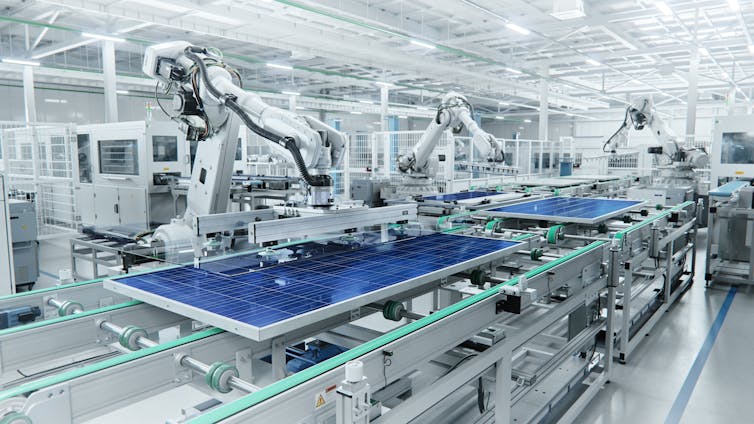New solar cells break efficiency record – they could eventually supercharge how we get energy from the Sun

مجلة المذنب نت متابعات عالمية:
The sight of solar panels installed on rooftops and large energy farms has become commonplace in many regions around the world. Even in grey and rainy UK, solar power is becoming a major player in electricity generation.
This surge in solar is fuelled by two key developments. First, scientists, engineers and those in industry are learning how to make solar panels by the billions. Every fabrication step is meticulously optimised to produce them very cheaply. The second and most significant is the relentless increase in the panels’ power conversion efficiency – a measure of how much sunlight can be transformed into electricity.
The higher the efficiency of solar panels, the cheaper the electricity. This might make you wonder: just how efficient can we expect solar energy to become? And will it make a dent in our energy bills?
Current commercially available solar panels convert about 20-22% of sunlight into electrical power. However, new research published in Nature has shown that future solar panels could reach efficiencies as high as 34% by exploiting a new technology called tandem solar cells. The research demonstrates a record power conversion efficiency for tandem solar cells.
What are tandem solar cells?
Traditional solar cells are made using a single material to absorb sunlight. Currently, almost all solar panels are made from silicon – the same material at the core of microchips. While silicon is a mature and reliable material, its efficiency is limited to about 29%.
To overcome this limit, scientists have turned to tandem solar cells, which stack two solar materials on top of each other to capture more of the Sun’s energy.
In the new nature paper, a team of researchers at the energy giant LONGi has reported a new tandem solar cell that combines silicon and perovskite materials. Thanks to their improved sunlight harvesting, the new perovskite-silicon tandem has achieved a world record 33.89% efficiency.
Perovskite solar materials, which were discovered less than two decades ago, have emerged as the ideal complement to the established silicon technology. The secret lies in their light absorption tuneability. Perovskite materials can capture high energy, blue light more efficiently than silicon.
In this way, energy losses are avoided and the total tandem efficiency increases. Other materials, called III-V semiconductors, have also been used in tandem cells and achieved higher efficiencies. The problem is they are hard to produce and expensive, so only small solar cells can be made in combination with focused light.
The scientific community is putting tremendous effort into perovskite solar cells. They have kept a phenomenal pace of development with efficiencies (for a single cell in the lab) rising from 14% to 26% in only 10 years. Such advancements enabled their integration into ultra-high-efficiency tandem solar cells, demonstrating a pathway to scale photovoltaic technology to the trillions of Watts the world needs to decarbonise our energy production.
NREL, Author provided (no reuse)
The cost of solar electricity
The new record-breaking tandem cells can capture an additional 60% of solar energy. This means fewer panels are needed to produce the same energy, reducing installation costs and the land (or roof area) required for solar farms.
It also means that power plant operators will generate solar energy at a higher profit. However, due to the way that electricity prices are set in the UK, consumers may never notice a difference in their electricity bills. The real difference comes when you consider rooftop solar installations where the area is constrained and the space has to be exploited effectively.
The price of rooftop solar power is calculated based on two key measures. First, the total cost to install solar panels on your roof, and second, how much electricity they will generate over their 25 years of operation. While the installation cost is easy to obtain, the revenues from generating solar electricity at home are a bit more nuanced. You can save money by using less energy from the grid, especially in periods when it is costly, and you can also sell some of your surplus electricity back to the grid.
However, the grid operators will pay you a very small price for this electricity, so sometimes it is better to use a battery and store the energy so you can use it at night. Using average considerations for a typical British household, I have calculated the cash savings consumers would gain from rooftop solar electricity depending on the efficiency of the panels.
If we can improve panel efficiency from 22% to 34% without
increasing the installation cost, savings in electricity bills will rise from £558ְ/year up to £709/year. A 20% bump in cash savings that would make solar rooftops extremely attractive, even in grey and cloudy Britain.

IM Imagery / Shutterstock
So when can we buy these new solar panels?
As research continues, considerable efforts are being made to scale up this technology and ensure its long-term durability. The record breaking tandem cells are made in laboratories and are smaller than a postage stamp. Translating such high performance to metre-square areas remains a vast challenge.
Yet, we are making progress. Earlier this month, Oxford PV, a solar manufacturer at the forefront of perovskite technology, announced the first sale of its newly developed tandem solar panels. They have successfully tackled the challenges of integrating two solar materials and making durable and reliable panels. While they are still far from 34% efficiencies, their work shows a promising route for next generation solar cells.
Another consideration is the sustainability of the materials used in tandem solar panels. Extracting and processing some of the minerals in solar panels can be hugely energy intensive. Besides silicon, perovskite solar cells require the elements lead, carbon, iodine and bromine as components to make them work properly. Connecting perovskite and silicon also requires scarce materials containing an element called indium, so there is plenty of research still required to address these difficulties.
Despite the challenges, the scientific and industrial community remains committed to developing tandem solar devices that could be integrated into almost anything: cars, buildings and planes.
The recent developments toward high efficiency perovskite-silicon tandem cells indicate a bright future for solar power, ensuring solar continues to play a more prominent role in the global transition to renewable energy.
نشكركم على قراءة المنشور عبر مجلة المذنب نت, المتخصصة في التداول والعملات الرقمية والمشفرة















